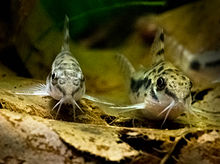Marbled dwarf catfish
| Marbled dwarf catfish | ||||||||||||
|---|---|---|---|---|---|---|---|---|---|---|---|---|

Marbled dwarf catfish ( Corydoras habrosus ) |
||||||||||||
| Systematics | ||||||||||||
|
||||||||||||
| Scientific name | ||||||||||||
| Corydoras habrosus | ||||||||||||
| Weitzman , 1960 |
The marbled dwarf catfish (also saddle dwarf armored catfish or checkerboard armored catfish) ( Corydoras habrosus ) (Greek: habrosus = pretty, appealing) is one of the smallest freshwater ornamental fish of the genus Corydoras . It becomes three to four inches long.
features
The marbled dwarf catfish has an unmistakable pattern: the basic color is silvery-shiny to olive, points in dark brown to black pattern the flanks, dorsal and caudal fins, the lateral line is decorated with black spots. Like all Corydoras species, C. habrosus is an intestinal breather that swims to the surface of the water at regular intervals in order to take in atmospheric air with its mouth.
ecology
Occurrence
The marbled dwarf catfish lives in rivers and streams of tropical South America in Colombia and Venezuela in the Orinoco , Rio Casanare , Rio Salinas and the Rio Pajo Viejo . The waters in which the marbled dwarf catfish occur have the following water values:
- a pH of 6 to 7.5
- a GH value of 2 to 22 ° d
- a KH value of 1 to 12 °
- and a temperature of 22 to 26 ° C.
Reproduction
In the wild, the armored catfish perform their typical mating behavior after the rainy season , when the water has warmed up again. After the rainy season there are a lot of suspended matter and therefore also prey in the water. The animals perform a special mating behavior in which the male circles the female and twitches strongly. The female looks for well-suited places for spawning protected stones and leaves in order to then attach the 40 or so eggs to them, which the males then fertilize.
nutrition
The marbled dwarf catfish is omnivorous and feeds by looking for algae, detritus , small animals and parts of plants on and near the ground .
Aquaristics
The animals are schooling fish and should be kept in groups of at least eight if they are kept in an aquarium . However, care should be taken not to add fish that are too large or predatory. The marbled dwarf catfish is very peaceful and can easily be socialized with smaller fish or shrimp. A soft, not sharp-edged substrate is important (sand is ideal), as otherwise the animals can injure their barbels. It can be kept in tanks from 50 liters.
breed
It is a species that is easy to breed. Readiness for spawning is initiated by simulating a rainy season (strong, abrupt partial water changes). Successful breeding requires one female and two to three males. A female lays around 40 eggs one after the other, which are glued to large leaves, stones or simply to the panes of the aquarium. The females are characterized by their fullness and their round ventral fins instead of the pointed ventral fins of the males. The eggs can be separated from the adults after a short time, but they do not have to. Compared to many other Corydoras species, the marbled dwarf catfish is not a spawning predator and does not eat the small larvae either. At 26 to 28 ° C, the larvae need about four days to hatch. The larvae are very small and almost transparent. Two to three days after hatching, when the yolk sac has been used up, the larvae can be fed with Artemia nauplii. The finest flake feed made from algae and compound feed can be given later.
Lining
The following food is also suitable in the aquarium: Live food ( Artemia , mosquito larvae , Grindal worms ), frozen food ( Cyclops ) and dry food (tablets, food flakes). He's always looking for something to eat on the floor and rummaging through it with his barbels .
literature
- Hans-Georg Evers : Armored catfish. Ulmer Verlag, Stuttgart 1994, ISBN 3-8001-7286-0 .
Web links
- Marbled dwarf catfish on Fishbase.org (English)
- Catfish at zierfisch-ratgeber.org
- Marbled dwarf catfish at Aqualistix
- Marbled dwarf catfish at PlanetCatfish
- Marbled dwarf catfish at aqua4you
Individual evidence
- ↑ Werner Krafczyk: Breeding report Corydoras habrosus. on www.welse.net


